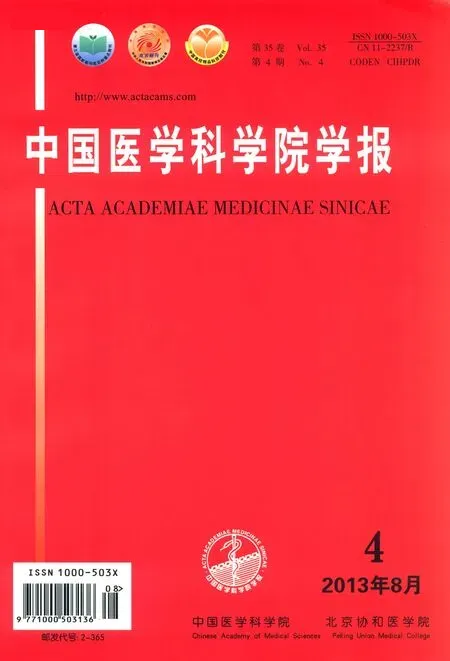甲状腺癌分子发病机制研究进展
2013-01-25阿勒哈孟庆彬于健春康维明曹战江田树波
阿勒哈,孟庆彬,于健春,康维明,曹战江,田树波
中国医学科学院 北京协和医学院 北京协和医院基本外科,北京100730
甲状腺癌是世界范围内发病率增速最快的肿瘤[1],目前在我国发病率居肿瘤发病率第10位,总的年龄调整发病率为4.21/10万,是最常见的内分泌癌[2]。由于甲状腺癌复发率较高,致使其不可治愈性和死亡率增加[3]。在甲状腺癌不同的生物学行为鉴别及预后判断方面,传统的临床病理学指标作用有限,到目前为止对于高侵袭性甲状腺癌的治疗仍然非常困难[4]。
不同组织学类型的甲状腺癌具有不同的细胞来源、特征和临床预后。约95%甲状腺癌来源于甲状腺滤泡上皮细胞,包括乳头状甲状腺癌 (papillary thyroid cancer,PTC)(80%)、滤泡状甲状腺癌 (follicular thyroid cancer,FTC)(10%~15%)、低分化型甲状腺癌 (poorly differentiated thyroid cancer,PDTC)和未分化甲状腺癌 (anaplastic thyroid cancer,ATC)(1%~2%),其中,PTC和FTC传统定义为分化型甲状腺癌[5-6];还有一小部分甲状腺癌来源于滤泡旁C细胞,称为甲状腺髓样癌 (medullary thyroid cancer,MTC),其主要分子发病机制为RET基因突变所引起的RET信号异常活化[7]。基因突变,如:BRAF、RAS、PIK3CA、PTEN、TP53和β-catenin突变,以及表观遗传学改变,如:基因异常甲基化是甲状腺癌发生的重要始动因素。甲状腺癌分子发病机制涉及多种信号通路的异常活化,如:丝裂原激活的蛋白激酶 (mtogen-activated protein kinase,MAPK)、磷脂酰肌醇-3-羟激酶/蛋白激酶 B(phosphatidylinositol 3-kinase/protein kinase B,PI3K/AKT)、核因子 κB(nuclear factor-κB,NF-κB)、Ras 相关域家族/巨噬细胞刺激因子1/叉形头转录因子O3(ras association domain family/macrophage stimulating 1/forkhead box O3,RASSF/MST1/FOXO3)、果蝇 WNT同源基因/β-连锁蛋白 (WNT/β-catenin)、低氧诱导因子1α (hypoxia inducible factor 1α,HIF1α)和促甲状腺激素/促甲状腺激素受体 (thyroid stimulating hormone/thyroid stimulating hormone receptor,TSH/TSHR)信号通路。随着对甲状腺癌分子发病机制的深入研究,生物靶向治疗逐渐提上日程,本文主要总结了滤泡上皮细胞来源甲状腺癌常见的遗传学改变及分子发病机制。
基因突变
BRAF点突变BRAF点突变产生BRAFV600E突变蛋白可引起此丝/苏氨酸激酶持续活化。研究发现,BRAFV600E突变与典型PTC预后较差的临床病理结局指标,如:侵袭性病理指标、复发增加、放射性碘亲和力降低以及治疗失败等密切相关[8]。经典的PTC的BRAF突变率高达75.3%,特别是在未合并慢性淋巴细胞性甲状腺炎的PTC患者中,与较大的肿瘤直径、多中心、甲状腺外浸润和淋巴结转移等病理指标密切相关[8-11]。BRAF突变也与典型PTC的不良预后密切相关[12-15],但是BRAFV600E突变状态在经典PTC治疗及预后评估中的作用尚需进一步研究。研究发现,BRAFV600E转基因鼠能够发展为侵袭性原发性甲状腺癌[16]。Ⅰ期临床研究显示,选择性BRAF阻断剂威罗菲尼对BRAFV600E突变的转移性PTC患者似乎具有非常有希望的临床疗效[17]。最新研究发现,糖酵解酶,如丙酮酸激酶 (pyruvate kinase M2,PKM2)的过表达与PTC细胞的快速增殖密切相关[18]。而BRAF突变与PTC细胞PKM2过表达密切相关。
RAS突变甲状腺癌第2常见的基因突变是RAS突变。RAS与GTP结合而活化:RAS的内源性GTP酶活性可以水解GTP,使RAS-GTP转化为非活化的RASGDP形式,进而终止RAS信号[19]。RAS突变后其内源性GTP酶活性丧失,可使RAS处于持续的GTP结合活化状态。3个RAS亚型 (HRAS、KRAS和NRAS)中,NRAS突变在甲状腺癌中最常见,并以密码子12和61最常见[19]。在甲状腺癌发病中,RAS突变主要激活PI3CK-AKT信号通路[20-21]。转基因鼠实验研究发现,KRAS突变联合PTEN缺失可很快诱导发生侵袭性 FTC[22]。
PTEN-PI3K-AKT通路相关基因突变PTEN突变激活PI3CK-AKT信号通路是Cowden综合征中FTC发生癌变的重要遗传学基础[23]。编码PI3K的p110α催化亚基的PIK3CA突变,在甲状腺癌特别是在FTC、PDTC和 ATC中非常常见[20-21]。
端粒末端转移酶基因突变Liu等[24]研究发现,端粒末端转移酶 (telomerase reverse transcriptase,TERT)基因启动子区突变在侵袭性甲状腺癌,如高细胞型甲状腺乳头状癌 (tall-cell papillary thyroid cancers,TCPTC)、PDTC、ATC和BRAF突变的PTC中发生率明显增高。
β-catenin基因突变β-catenin是广泛表达在细胞浆内的一类蛋白,该蛋白在E-cadherin调节的细胞与细胞间黏附中发挥关键作用,并且是WNT信号通路中重要的下游信号分子。研究显示,β-catenin在ATC中的突变率高达60%~65%,并与这种肿瘤的高侵袭性密切相关[19,25]。
基因扩增或基因拷贝数增加
癌基因扩增是甲状腺肿瘤发生中的另外一种重要遗传学机制,特别是编码受体酪氨酸激酶 (receptor tyrosine kinases,RTKs)的基因扩增非常常见[21]。此外,PI3K-AKT信号通路成员包括PIK3CA、PIK3CB、PDK1、AKT1和AKT2基因拷贝数增加在甲状腺癌中也非常常见[20-21,26],并且在甲状腺癌与甲状腺良性肿瘤鉴别诊断中发挥重要作用[27]。研究发现,甲状腺癌中PIK3CA基因扩增比其突变相对常见,并且可能是部分甲状腺癌中PI3K/AKT信号通路活化的重要机制之一[28]。
基因易位
基因易位导致甲状腺癌原癌基因重排,其中以1987年就发现的RET/PTC重排最典型[29-30]。原癌基因RET定位在人类染色体10q11.2,其编码的跨膜酪氨酸激酶受体参与细胞分化和增殖的调控。迄今为止,文献报道的甲状腺癌REI/PTC基因重排已达到13种之多,其中以RET/PTC1和 RET/PTC3最具代表性[29]。50%~80%放射性暴露引起的甲状腺癌中可发现RET/PTC重排[31]。但是,基因易位在甲状腺癌发生发展中的作用尚需进一步深入研究。
表观遗传学修饰 (异常甲基化)
基因异常甲基化在甲状腺癌中非常常见。PTC患者中,BRAFV600E基因突变与许多抑癌基因如TIMP3、SLC5A8、DAPK1和 RARB等高甲基化状态有关[32]。近期研究发现,BRAFV600E基因突变通过改变一系列重要靶基因的甲基化状态进而调控PTC的肿瘤发生[32]。未分化型甲状腺癌常出现特征性的DNA启动子区低甲基化而非高甲基化,其临床意义尚需进一步深入研究[33]。
信号传导通路的改变
MAPK信号通路在调节细胞增殖和肿瘤发生中发挥重要作用。研究发现,BRAFV600E突变、RAS突变以及RET/PTC重排易位等异常激活MAPK信号通路,在甲状腺癌的发病中发挥重要作用;同时,PI3K-AKT信号通路、RASSF1-MST1-FOXO3信号通路、NF-κB信号通路、WNT-β-catenin信号通路、HIF-1α信号通路以及甲状腺刺激激素受体信号通路也在甲状腺癌的发病中发挥重要作用[19]。
总之,甲状腺癌发病率逐年上升,传统的临床病理学指标在高侵袭性甲状腺癌的诊治方面作用有限,基因突变、异常扩增以及异常甲基化在甲状腺癌发病中发挥重要作用,分子病理学研究的进步为甲状腺癌的分子诊断、预后判断以及分子靶向治疗提供了新的机遇。
[1]Kilfoy BA,Zheng T,Holford TR,et al.International patterns and trends in thyroid cancer incidence,1973-2002[J].Cancer Causes Control,2009,20(5):525-531.
[2]Chen W,Zheng R,Zhang S,et al.Report of incidence and mortality in China cancer registries,2009 [J].Chin J Cancer Res,2013,25(1):10-21.
[3]Tuttle RM,Ball DW,Byrd D,et al.Thyroid carcinoma[J].J Natl Compr Canc Netw,2010,8(11):1228-1274.
[4]Wreesmann VB,Singh B.Clinical impact of molecular analysis on thyroid cancer management[J].Surg Oncol Clin N Am,2008,17(1):1-35,vii.
[5]Fassnacht M,Kreissl MC,Weismann D,et al.New targets and therapeutic approaches for endocrine malignancies[J].Pharmacol Ther,2009,123(1):117-141.
[6]Catalano MG,Fortunati N,Boccuzzi G.Epigenetics modifications and therapeutic prospects in human thyroid cancer[J].Front Endocrinol(Lausanne),2012,3:40.
[7]Fugazzola L,De Leo S,Perrino M.The optimal range of RET mutations to be tested:European comments to the guidelines of the American Thyroid Association [J].Thyroid Res,2013,6(Suppl 1):S8.
[8]Xing M,Westra WH,Tufano RP,et al.BRAF mutation predicts a poorer clinical prognosis for papillary thyroid cancer[J].J Clin Endocrinol Metab,2005,90(12):6373-6379.
[9]Lim JY,Hong SW,Lee YS,et al.Clinicopathologic implications of the BRAFV600E mutation in papillary thyroid cancer;a subgroup analysis of 3130 cases in a single center[J].Thyroid,2013,http://online.liebertpub.com/doi/abs/10.1089/thy.2013.0036.
[10]Li C,Lee KC,Schneider EB,et al.BRAF V600E mutation and its association with clinicopathological features of papillary thyroid cancer:a meta-analysis[J].J Clin Endocrinol Metab,2012,97(12):4559-4570.
[11]Lupi C,Giannini R,Ugolini C,et al.Association of BRAF V600E mutation with poor clinicopathological outcomes in 500 consecutive cases of papillary thyroid carcinoma[J].J Clin Endocrinol Metab,2007,92(11):4085-4090.
[12]Elisei R,Viola D,Torregrossa L,et al.The BRAF(V600E)mutation is an independent,poor prognostic factor for the outcome of patients with low-risk intrathyroid papillary thyroid carcinoma:single-institution results from a large cohort study[J].J Clin Endocrinol Metab,2012,97(12):4390-4398.
[13]Xing M,Alzahrani AS,Carson KA,et al.Association between BRAF V600E mutation and mortality in patients with papillary thyroid cancer[J].JAMA,2013,309(14):1493-1501.
[14]Elisei R,Ugolini C,Viola D,et al.BRAF(V600E)mutation and outcome of patients with papillary thyroid carcino-ma:a 15-year median follow-up study[J].J Clin Endocrinol Metab,2008,93(10):3943-3949.
[15]Fernandez IJ,Piccin O,Sciascia S,et al.Clinical significance of BRAF mutation in thyroid papillary cancer[J].Otolaryngol Head Neck Surg,2013,148(6):919-925.
[16]Knauf JA,Ma X,Smith EP,et al.Targeted expression of BRAFV600E in thyroid cells of transgenic mice results in papillary thyroid cancers that undergo dedifferentiation [J].Cancer Res,2005,65(10):4238-4245.
[17]Kim K,Cabanillas M,Lazar AJ,et al.Clinical responses to vemurafenib in patients with metastatic papillary thyroid cancer harboring V600EBRAF mutation [J].Thyroid,2013,http://online.liebertpub.com/doi/abs/10.1089/thy.2013.0057.
[18]Feng C,Gao Y,Wang C,et al.Aberrant overexpression of pyruvate kinase M2 is associated with aggressive tumor features and the BRAF mutation in papillary thyroid cancer[J].J Clin Endocrinol Metab,2013,http://jcem.endojournals.org/content/early/2013/07/10/jc.2012-4258.long.
[19]Xing M.Molecular pathogenesis and mechanisms of thyroid cancer[J].Nat Rev Cancer,2013,13(3):184-199.
[20]Abubaker J,Jehan Z,Bavi P,et al.Clinicopathological analysis of papillary thyroid cancer with PIK3CA alterations in a Middle Eastern population [J].J Clin Endocrinol Metab,2008,93(2):611-618.
[21]Liu Z,Hou P,Ji M,et al.Highly prevalent genetic alterations in receptor tyrosine kinases and phosphatidylinositol 3-kinase/akt and mitogen-activated protein kinase pathways in anaplastic and follicular thyroid cancers[J].J Clin Endocrinol Metab,2008,93(8):3106-3116.
[22]Miller KA,Yeager N,Baker K,et al.Oncogenic Kras requires simultaneous PI3K signaling to induce ERK activation and transform thyroid epithelial cells in vivo[J].Cancer Res,2009,69(8):3689-3694.
[23]Gustafson S,Zbuk KM,Scacheri C,et al.Cowden syndrome[J].Semin Oncol,2007,34(5):428-434.
[24]Liu X,Bishop J,Shan Y,et al.Highly prevalent TERT promoter mutations in aggressive thyroid cancers[J].Endocr Relat Cancer,2013,20(4):603-610.
[25]Garcia-Rostan G,Tallini G,Herrero A,et al.Frequent mutation and nuclear localization of beta-catenin in anaplastic thyroid carcinoma [J].Cancer Res,1999,59(8):1811-1815.
[26]Xing JC,Tufano RP,Murugan AK,et al.Single nucleotide polymorphism rs17849071 G/T in the PIK3CA gene is inversely associated with follicular thyroid cancer and PIK3CA amplification [J].PLoS One,2012,7(11):e49192.
[27]Liu Y,Cope L,Sun W,et al.DNA copy number variations characterize benign and malignant thyroid tumors[J].J Clin Endocrinol Metab,2013,98(3):E558-E566.
[28]Wu G,Mambo E,Guo Z,et al.Uncommon mutation,but common amplifications,of the PIK3CA gene in thyroid tumors[J].J Clin Endocrinol Metab,2005,90(8):4688-4693.
[29]Romei C,Elisei R.RET/PTC Translocations and clinicopathological features in human papillary thyroid carcinoma[J].Front Endocrinol(Lausanne),2012,3:54.doi:10.3389/fendo.2012.00054.
[30]Fusco A,Grieco M,Santoro M,et al.A new oncogene in human thyroid papillary carcinomas and their lymph-nodal metastases[J].Nature,1987,328(6126):170-172.
[31]Hieber L,Huber R,Bauer V,et al.Chromosomal rearrangements in post-Chernobyl papillary thyroid carcinomas:evaluation by spectral karyotyping and automated interphase FISH[J].J Biomed Biotechnol,2011,http://www.hindawi.com/journals/bmri/2011/693691/.
[32]Hu S,Liu D,Tufano RP,et al.Association of aberrant methylation of tumor suppressor genes with tumor aggressiveness and BRAF mutation in papillary thyroid cancer[J].Int J Cancer,2006,119(10):2322-2329.
[33]Rodriguez-Rodero S,Fernandez AF,Fernandez-Morera JL,et al.DNA methylation signatures identify biologically distinct thyroid cancer subtypes[J].J Clin Endocrinol Metab,2013,98(7):2811-2821.
